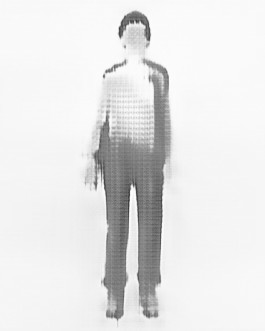BIG BORING THINGS
27 January 2020
Here will you learn about: bright shiny things like face filters becoming normal and boring. A cool way to start your obituary. The status quo of AR interfaces. The term digital twin. The rlab in New York. A guy calling himself SkarredGhost. And an interesting Harvard Business Review article about organizations and their AR strategy, including a list of companies already applying AR and some questions to ask. The image above and the one on the index are by Nigerian artist Osinachi, using Microsoft Word as a canvas.
Apple CEO Tim Cook thinks augmented reality, or technology that overlays virtual objects onto the real world, is “the next big thing” that “will pervade our entire lives.” Is he intrigued? I mean on a personal level?
The next big thing. Yet again. Get hyped. Feel the need. Buy new things. Spent time with them. Get bored. Repeat. It all starts again. And again. Until one sunny day. It will not. End of story.
A couple of days ago i read this well-written obituary by Ken Fuson: Ken Fuson, born June 23, 1956, died Jan. 3, 2020 in at Nebraska Medical Center in Omaha, of liver cirrhosis, and is stunned to learn that the world is somehow able to go on without him.
Okay, AR. Still intrigued. But the beginning of 2020 thought me an interesting lesson. Exactly one year ago i was totally into face filters. They were new. They were exciting. And very few people were using them. Fast Forward. There is a hell lot of face filters out there. There are micro-trends (What ... food are you...). And people are adopting, using them and already making fun of using them. Isn´t that exactly what was supposed to happen? Sure thing. Yet it always feels like somewhat loosing your hyped little indie pop star to the masses, loosing cultural capital while no one thinks of you being among the happy few. Nobody cares.

Ian Bogost, game theory guy and Atlantic writer once wrote a nice little text about the smartphone becoming a mundane every day object and finally arriving in the mainstream. No need to discuss specs, download fancy apps. It is just there, doing the thing it is supposed to do. Like an object in a kitchen. This thought sounds rather banal but it struck me, having been into "smartphone reporting" for ages, pushing possibilities back in the days. Nobody cares. Why should they. There is an unbelievable gap between using things in 2009 and 2019. Yep. Really, Watson? Question is how not to get bored, stay on track, find a niche and finally how to monetize skills and knowledge before everybody else does. It is a question of timing. And this question yet again does not seem to have an easy and obvious answer in the field of AR/VR/MR/XR/Spatial Computing.
There were quite a few things in the last weeks that struck me concerning AR/VR. One thing is the infancy of user interfaces due to technical limitations. While AR is already there and has been for quite some time in the business world – will write about that in a second – the products on the consumer market lack a certain kind of matureness.
Check out these swimming goggles above. Looks like the interface of a calculator back in 1987. For now. I know. But still. Feels strange. Swimming without these information on a contact lense will probably seem strange in the years to come.
Someone who has been popping up on my radar recently a lot is SkarredGhost. He has published some decent predictions for VR 2020, is publishing a thing called XR Week Peek. And some months ago he participated to the writing of the White Paper by @IEEEorg on "Symbiotic Autonomous Systems".
The paper has a nice section about Digital Reality Versus Reality starting on page 82.

I want to learn more about the concept of the "different personal digital twins". Will come back to that.
Another starting point to find interesting stuff has been the New Yorker rlab. They offer two classes that got me excited: UX Design for AR/VR and Developing an AR strategy for your company. Something i would like to work on in the years to come. The syllabus linked to a rather lengthy Harvard Business Review article from 2017 (!). Of course i printed the entire thingy in order to underline things with a pink sharpie.

Nothing new here. But plain sentences that explain the obvious.
* There is a fundamental disconnect between the wealth of digital data available to us and the physical world in which we apply it.
* AR will affect companies in every industry, it will transform how we learn, make decisions, and interact with the physical world.
* AR will become the new interface between humans and machines, bridging the digital and physical worlds.
* AR enables a new information-delivery paradigm.
Apart from that there is a rather extensive list of companies applying AR/VR in 2017, including use cases from: NewportNewsShipbuilding, AccuVein, Bosch Rexroth, Boeing, Lee Company, Ford, the U.S. Departement of Homeland Security, BP, Volkswagen, Iconics, DHL, AZEK, Wayfair, IKEA, KPN, Xerox, U.S. Navy.
And there is a list with essential questions for companies concerning a future AR strategy, like: What is the range of AR opportunities in the industry, and in what sequence should they be pursued? And another list with five key questions, like: Which development capabilities will be required?









